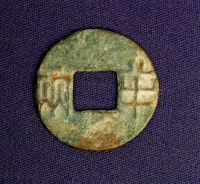|
Chin Ban-liang ( bronze currency of the Chin Dynasty) |
|
Tags: bronzes | currency
 Early in the period of the Warring States, the Qin Ban Liang currency came into circulation. Later, Emperor Qin unified the six kingdoms, discontinuing the different national currencies, and used the Qin BanLiang, which is a round coin with square hole in the middle, and standardized it as “1.2 inches in diameter, with a weight of twelve Zhu”. To convert it to the metric system, it is 2.8 centimeters long, and weighs around eight grams. The flat round shape and square inside hole of the Ba Liang currency probably derives from the Huan Currency, which is round both inside and outside. The round shape and square hole represents the sky (the circle) and the earth (the square), and symbolized the completeness of the world, The style of this round currency was very convenient. It was easy to string many coins together on a cord, making it easy to carry. This solved the complicated issues that the heavy and inconvenient knife currency and Bu currency caused. Therefore, Qin Banliang currency was an important milestone in the history of Chinese currency by enabling coins to be easily circulated.
Early in the period of the Warring States, the Qin Ban Liang currency came into circulation. Later, Emperor Qin unified the six kingdoms, discontinuing the different national currencies, and used the Qin BanLiang, which is a round coin with square hole in the middle, and standardized it as “1.2 inches in diameter, with a weight of twelve Zhu”. To convert it to the metric system, it is 2.8 centimeters long, and weighs around eight grams. The flat round shape and square inside hole of the Ba Liang currency probably derives from the Huan Currency, which is round both inside and outside. The round shape and square hole represents the sky (the circle) and the earth (the square), and symbolized the completeness of the world, The style of this round currency was very convenient. It was easy to string many coins together on a cord, making it easy to carry. This solved the complicated issues that the heavy and inconvenient knife currency and Bu currency caused. Therefore, Qin Banliang currency was an important milestone in the history of Chinese currency by enabling coins to be easily circulated.
National Museum of History
|